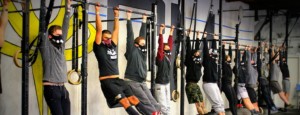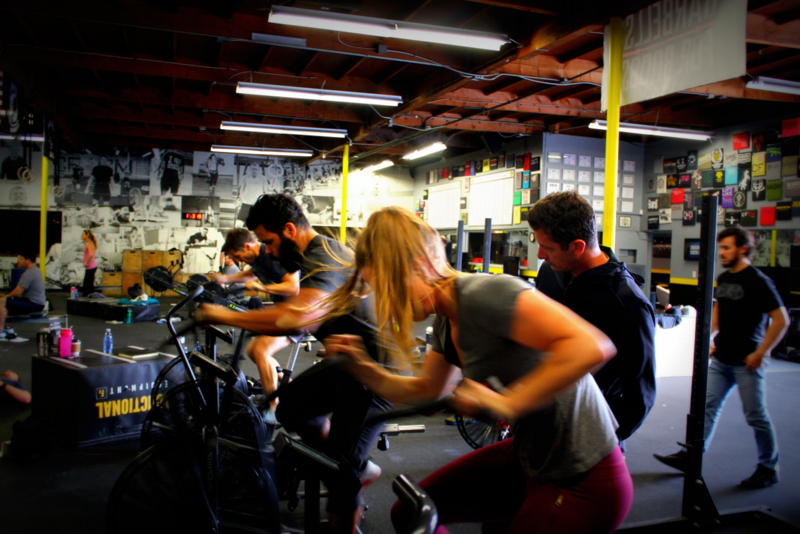By Brian MacKenzie and Rachael Colacino
You may have seen the announcements for our upcoming Art of Breath clinics. As we finalize details for spreading the benefits of breath training worldwide, we’d like to share our journey and what we’ve learned along the way.
We’ve spent the past several years focused on training our muscular and cardiovascular systems, but have paid little to no attention to our pulmonary system. The potential health benefits are numerous, starting with an improvement in overall health simply by breathing in more oxygen and expelling more carbon dioxide.
 Our emphasis on the importance of breathing in sport and for overall wellness has evolved over the past four years. Through our work with Training Mask we gained better motor control and access to the diaphragm. Any resistance breathing device like the Training Mask or Expand-a-Lung can help, especially during warm-ups and when used alone for breathing exercises (full inhales and full exhales for 2-3 minutes). We combined that work with the teachings of Wim Hof and realized that breathing was the missing piece- the link between our body of work and the goals we set for ourselves as athletes and coaches. This led to many other practices, including Yoga (Prana), the Freediving and Big Wave Riding communities, and even Brain Training. From the education and experiences we developed a trove of breathing techniques specifically for our athletes who are looking for better athletic performance and improved overall health, as there is not one method that fits all.
Our emphasis on the importance of breathing in sport and for overall wellness has evolved over the past four years. Through our work with Training Mask we gained better motor control and access to the diaphragm. Any resistance breathing device like the Training Mask or Expand-a-Lung can help, especially during warm-ups and when used alone for breathing exercises (full inhales and full exhales for 2-3 minutes). We combined that work with the teachings of Wim Hof and realized that breathing was the missing piece- the link between our body of work and the goals we set for ourselves as athletes and coaches. This led to many other practices, including Yoga (Prana), the Freediving and Big Wave Riding communities, and even Brain Training. From the education and experiences we developed a trove of breathing techniques specifically for our athletes who are looking for better athletic performance and improved overall health, as there is not one method that fits all.
Most of the athletes with whom we worked, including ourselves, did not know or understand how to take in a full breath of air. We were shallow chest breathers. And the more we worked with it, the more we realized that not taking in enough air comes down to issues with position, which is the foundation of our PSE training philosophy. In a good position you move well. Well guess what – in a good position you also breathe well.
Humans only use 15% of our lung capacity, but 70% of our toxins are removed through respiration, which poses a problem when we aren’t using our pulmonary system to its full capacity. Look at our lives, at our movement. If we aren’t moving well we aren’t breathing well, and if we aren’t breathing well we aren’t reaping the full health benefits.
Start Your Own Breathing Practice
Start your own breath practice by learning how to access your diaphragm. Usually by just using a straw, you can mimic diaphragmatic breathing by fully inhaling and fully exhaling for 5 to 10 minutes a day (this supplies enough resistance to engage the diaphragm and gets us to make positional changes). That’s all it will take to change your physiology. To make you feel better. Don’t hold your breath – just inhale a smooth, long deep breath with a full smooth exhale.
Once you have the mechanics down, use the Breath Test + Calculator to help dial in your own Breathing Protocol to help increase your capacity and practice your consciousness of breath. Use the Apnea Breathing for down regulation to help you recover and get a good night’s sleep. And use the Cadence Breathing  Protocol for up regulation to help warm up your respiratory system for a workout or just to get up and going in the morning.
Protocol for up regulation to help warm up your respiratory system for a workout or just to get up and going in the morning.
If you want to further your practice, keep an eye for an Art of Breath Clinic coming your way. These clinics will offer a much more refined and fundamental approach to breathing methods and how they benefit sport performance and overall wellness. The clinics will be experiential, and will introduce the physiology, anatomy and practical uses of many traditional breathing methods and resistance breathing devices, along with some of the newer hyperventilating techniques. Our first Clinic is scheduled in Minneapolis, MN on February 25 with more locations coming very soon.
